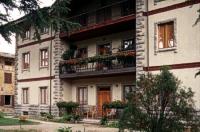
San Pietro al Natisone
 On account of the number of its inhabitants this municipality is considered the main town of the Natisone Valleys. The most ancient traces of human settlements were discovered in the borough of Biarzo, where recent diggings in a cave have brought forth manufacts dating back to the upper Palaeolithic and the Neolithic period.
On account of the number of its inhabitants this municipality is considered the main town of the Natisone Valleys. The most ancient traces of human settlements were discovered in the borough of Biarzo, where recent diggings in a cave have brought forth manufacts dating back to the upper Palaeolithic and the Neolithic period.
S. Pietro al Natisone was the obligatory passage for all those who in ancient times travelled North to the Danube. Especially under the Lombards and the Patriarchs, it became a strategically important site. The terraces, cliffs and gorges that the river has created in the part of the valley where S. Pietro al Natisone stands, yield a fascinating view covering all the phases of a long, complex geological process. Hence hikers and gourmets alike will find innumerable opportunities to indulge in their favourite activity: Strucchi and gubana are typical examples of the local cakes.
As to the history of this town, it is a long sequence of invasions by several populations. The first to settle in this area were the Veneti (around 9th c. BC); the Celtic and Romans followed. In the 5th c. new invaders came from the East: the Visigoths, the Ostrogoths, the Huns and the Goths. With the Lombards, who crossed the Eastern Alps in 568, a period of relative stability began. In the 7th c. a gradual, steady and permanent flow of Slavonic settlers began. Subsequently, the area belonged to the chamberlain of Antro (a feudatory of the Patriarchate of Aquileia). The fact that the ethnic and cultural characteristics of the Slavonic population could be preserved for so long is to a large extent due to the configuration of the territory that offered no natural obstacles between it and the areas belonging to the chamberlain of Tolmino and the count of Gorizia. In the 15th c. the area was occupied by the Republic of Venice, and in the 18th c. French and Austrian occupations ensued.
by the Republic of Venice, and in the 18th c. French and Austrian occupations ensued.
In 1866 the territory came under the Italian state.
Among the main cultural assets, a visit to the church of Sant'Antonio Abate in Clenia, with its 14th c. frescoes, is highly recommended. Equally worth a visit: the church of San Quirino and that of San Bartolomeo in Vernasso.
more info: http://www.comune.sanpietroalnatisone.ud.it

